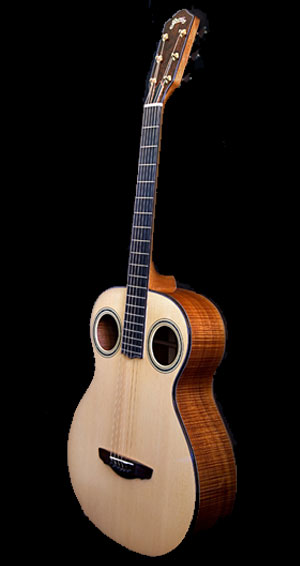 The double soundhole design does a few things better, or at least differrent, than a standard center soundhole guitar. In this design the traditional 3 7/8” – 4” round center soundhole, is replaced with two approximately 2 7/8” soundholes on either side of the fingerboard in the upper bout. The tonal changes most noticeable are the increase in sustain and the added richness to the bass. Having a larger area of soundboard that’s not interrupted by a soundhole, the double hole configuration allows for a fuller bass response, not unlike the difference between the richness of bass in a 15′ woofer compared to a 10″ woofer in a stereo system. Some of my customers use slack key tunings with a “C” in the bass, and this design is capable of better reproduction of those low tones. At the same time, the mids and trebles are maintained by a bracing pattern that is a close relative of the traditional “X” brace, but which uses another “X” up under the fingerboard. The lower bout “X” is slightly shifted to the treble side, which enhances the mids and trebles and further helps the bass by creating larger areas on the bass side. It also reduces the possibility of cancelation, or “washing” of the sound from side to side due to perfectly symetrical vibrating areas on the treble and bass sides.
The double soundhole design does a few things better, or at least differrent, than a standard center soundhole guitar. In this design the traditional 3 7/8” – 4” round center soundhole, is replaced with two approximately 2 7/8” soundholes on either side of the fingerboard in the upper bout. The tonal changes most noticeable are the increase in sustain and the added richness to the bass. Having a larger area of soundboard that’s not interrupted by a soundhole, the double hole configuration allows for a fuller bass response, not unlike the difference between the richness of bass in a 15′ woofer compared to a 10″ woofer in a stereo system. Some of my customers use slack key tunings with a “C” in the bass, and this design is capable of better reproduction of those low tones. At the same time, the mids and trebles are maintained by a bracing pattern that is a close relative of the traditional “X” brace, but which uses another “X” up under the fingerboard. The lower bout “X” is slightly shifted to the treble side, which enhances the mids and trebles and further helps the bass by creating larger areas on the bass side. It also reduces the possibility of cancelation, or “washing” of the sound from side to side due to perfectly symetrical vibrating areas on the treble and bass sides.
The upper bout of a flat top guitar is an area that is relatively limited acoustically, especially in comparison with the lower bout. It is a perfect location for the soundholes for a number of reasons. 1) The resonating area of the lower bout is enhanced. 2) The close proximity of the bracing under the fingerboard (the upper “X”) and the sides of the guitar to the two soundholes makes it unnecessary to use heavy bracing to support the edges of the soundholes, unlike the center hole design, where the hole is surrounded by substantial bracing. 3) The sound of the guitar is more prominent to the player, since the bass side hole is closer to the ear.
To sum it up, the double hole design produces a full, warm bass response and overall increase in sustain. The player also hears a more immediacy of tone to his/her ear . It sounds almost like holding a standard guitar up closer to your ear while playing.
One drawback for the double hole design is that for those players with a deep, aggresive pick attack, its easier to scratch the soundboard under the strings with the pick, since there’s no hole there. Tonewise, the single soundhole guitars have a slightly more punchy quality to the tone with greater attack, while the double holes lend themselves to a warmer, rounder kind of response more suited to fingerpicking. I hear the word “open” used by players who pick up this guitar for the first time.



